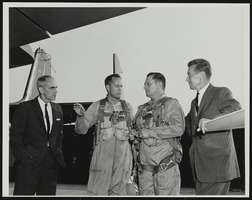Search the Special Collections and Archives Portal
Search Results
Howard Booth Papers
Identifier
Abstract
The Howard Booth Papers are comprised of the personal papers of environmental activist Howard Booth from 1964 to 2017. The collection includes information about Booth's efforts to help turn Red Rock Canyon into a National Conservation Area. Booth was a member of multiple conservation organizations and the collection includes meeting minutes and newsletters from the Toiyabe chapter of the Sierra Club. The collection also contains correspondence, newspaper clippings, official reports, newsletters, and meeting minutes collected by Booth from various environmental organizations. The papers also include numerous photographic slides with handwritten captions Booth took of Red Rock and the surrounding area from the early 1980s to 2000s.
Archival Collection

Photograph of a parade procession, New York, July 15, 1938
Date
Archival Collection
Description
Image

Howard Cannon visits Grumman Aircraft Engineering Plant at Bethpage, Long Island, New York: photographic print
Date
Archival Collection
Description
Image
Centennial Stories: Examining Our Past, "L.V. Strip Howard Hughes Era," CCTV-4 Clark County TV, 2009
Level of Description
Scope and Contents
Additional information from donor: Moderated by Mark Hall-Patton. Paul Winn, Geoff Schumacher, and Burton Cohen reflect on the impact Howard Hughes had on Las Vegas. Additional contribution by Bob Stoldal in video segments.
Archival Collection
Collection Name: Scott Rayer Collection of Television Programs about Las Vegas, Nevada
Box/Folder: Digital File 00
Archival Component
Howard Heckethorn oral history interview
Identifier
Abstract
Oral history interview with Howard Heckethorn conducted by Neil Dalmas on March 02, 1977 for the Ralph Roske Oral History Project on Early Las Vegas. This interview offers an overview of early education in Nevada. Mr. Heckethorn also discusses Stewart Ranch, Howard Hughes and the Hughes Site, and the migration of the Mormons to the Las Vegas area.
Archival Collection
Hughes HK-1 Hercules photographs, 1945-1947
Level of Description
Scope and Contents
Materials contain photographs of the HK-1 Hercules, otherwise known as the "Spruce Goose" or the "Flying Boat," from 1945 to 1947. The photographs primarily depict the construction, transportation, and storage of the plane, but also include the first and only test flight of the HK-1 above Los Angeles Harbor in 1947. Howard Hughes designed the HK-1 as the world's largest plane, capable of transporting large quantities of U.S. military hardware and personnel. In 1947, under the program's new designation H-4 Hercules, Hughes had the plane transported from his factory in Culver City, California to Los Angeles Harbor. On November 2, he piloted the plane during its only test flight. The U.S. Air Force abandoned the controversial project, and Hughes was called to testify before the Truman Committee of the U.S. Senate to justify the use of government funds on a program that never succeeded.
Archival Collection
Collection Name: Howard Hughes Public Relations Photograph Collection
Box/Folder: N/A
Archival Component
Howard Hughes' inventory of Scarface reels, includes domestic and international requests to find undamaged reels for Hughes' private viewing, 1955 November 03 to 1972 June 02
Level of Description
Archival Collection
Collection Name: Howard Hughes Film Production Records
Box/Folder: Box 377 (Restrictions apply)
Archival Component
Hughes Tool Company v. Benjamin Fielding, Commissioner of Licenses of the city of New York, New York and Arthur W. Wallander, Police Commissioner of New York, correspondence regarding court decision, 1947 January 20 to 1947 February 21
Level of Description
Archival Collection
Collection Name: Howard Hughes Film Production Records
Box/Folder: Box 165 (Restrictions apply)
Archival Component
Howard R. Hughes College of Engineering: Mero Structures, Inc. correspondence, product samples, subcontracts, and electrical details, 1988
Level of Description
Archival Collection
Collection Name: J. A. Tiberti Construction Records
Box/Folder: Box 095
Archival Component
